ZnO Nanoparticles for Photocatalytic Application in Alkali-Activated Materials
Abstract
1. Introduction
2. Results
2.1. Characterization
2.2. Photocatalytic Activity
2.3. Adsorption and Photocatalytic Kinetics
3. Materials and Methods
3.1. Materials
3.2. Preparation of the Alkali-Activated Materials
3.3. Addition of ZnO Nanostructures
3.4. Photodegradation Studies of Methylene Blue
3.5. Characterization Techniques
4. Conclusions
- The addition of nanometric size ZnO into the inorganic polymer matrices produces satisfactory photocatalytic results.
- Nanospheres show a better photocatalytic performance than nanorods, when both are mixed with the pastes. The photodegradation performance in SL-based pastes with a small percentage of nanoparticles functionalized with CMC showed that low kinetics of geopolymerization could help avoid the ZnO nanostructures’ breakdown.
- Functionalization of ZnO nanoparticles with CMC avoids its breakdown under highly basic pH conditions, increasing the photocatalytic performance.
- The MK matrix showed that the addition of ZnO nanospheres, functionalized and without functionalization, increased MB’s photodegradation more than without nanoparticles. The addition of nanorods showed a slight increase in the photocatalytic activity.
- In SL matrix, a little increase in the photodegradation of MB dye was observed when functionalized nanospheres were added. In the rest of the experiments, no significant results were obtained.
- The MB adsorption and photodegradation follow pseudo-second-order kinetics. In dark conditions, the adsorption effect was responsible for dye removal. Meanwhile, under UV irradiation, a combination of photodegradation and adsorption effects are responsible for the decrease in MB concentration.
- These new ZnO-based composites have an enormous potential for the removal of organic pollutants from wastewaters and important environmental applications.
Author Contributions
Funding
Acknowledgments
Conflicts of Interest
References
- Kühl, H. Slag Cement and Process of Making the Same. U.S. Patent 900,939, 13 October 1908. [Google Scholar]
- Li, C.; Sun, H.; Li, L. A review: The comparison between alkali-activated slag (Si + Ca) and metakaolin (Si + Al) cements. Cem. Concr. Res. 2010, 40, 1341–1349. [Google Scholar] [CrossRef]
- Provis, J.L.; Palomo, A.; Shi, C. Advances in understanding alkali-activated materials. Cem. Concr. Res. 2015, 78, 110–125. [Google Scholar] [CrossRef]
- Al-Zboon, K.; Al-Harahsheh, M.S.; Hani, F.B. Fly ash-based geopolymer for Pb removal from aqueous solution. J. Hazard. Mater. 2011, 188, 414–421. [Google Scholar] [CrossRef] [PubMed]
- El-Eswed, B.; Alshaaer, M.; Yousef, R.I.; Hamadneh, I.; Khalili, F. Adsorption of Cu(II), Ni(II), Zn(II), Cd(II) and Pb(II) onto Kaolin/Zeolite Based-Geopolymers. Adv. Mater. Phys. Chem. 2012, 2, 119–125. [Google Scholar] [CrossRef]
- Zhang, Y.; Liu, L. Fly ash-based geopolymer as a novel photocatalyst for degradation of dye from wastewater. Particuology 2013, 11, 353–358. [Google Scholar] [CrossRef]
- Khan, M.I.; Min, T.K.; Azizli, K.; Sufian, S.; Ullah, H.; Man, Z. Effective removal of methylene blue from water using phosphoric acid based geopolymers: Synthesis, characterizations and adsorption studies. Rsc. Adv. 2015, 5, 61410. [Google Scholar] [CrossRef]
- Mills, A.; Le Hunte, S. An overview of semiconductor photocatalysis. J. Photochem. Photobiol. A 1997, 108, 1–35. [Google Scholar] [CrossRef]
- Mahmoodi, N.M.; Arami, M.; Limaee, N.Y.; Gharanjig, K.; Nourmohammadian, F. Nanophotocatalysis using immobilized titanium dioxide nanoparticle: Degradation and mineralization of water containing organic pollutant: Case study of Butachlor. Mater. Res. Bull. 2007, 42, 797–806. [Google Scholar] [CrossRef]
- Mejía de Gutiérrez, R.; Villaquirán-Caicedo, M.A.; Guzmán-Aponte, L.A. Alkali-activated metakaolin mortars using glass waste as fine aggregate: Mechanical and photocatalytic properties. Constr. Build. Mater. 2020, 235, 117510. [Google Scholar] [CrossRef]
- Ibrahim, H.M.M. Photocatalytic degradation of methylene blue and inactivation of pathogenic bacteria using silver nanoparticles modified titanium dioxide thin films. World J. Microbiol. Biotechnol. 2015, 31, 1049–1060. [Google Scholar] [CrossRef]
- Wang, J.; Li, C.; Zhuang, H.; Zhang, J. Photocatalytic degradation of methylene blue and inactivation of Gram-negative bacteria by TiO2 nanoparticles in aqueous suspension. Food Control. 2013, 34, 372–377. [Google Scholar] [CrossRef]
- Jimenez-Relinque, E.; Rodriguez-Garcia, J.R.; Castillo, A.; Castellote, M. Characteristics and efficiency of photocatalytic cementitious materials: Type of binder, roughness and microstructure. Cem. Concr. Res. 2015, 71, 124–131. [Google Scholar] [CrossRef]
- Guzmán-Carrillo, H.R.; Rivera-Muñoz, E.M.; Cayetano-Castro, N.; Herrera-Basurto, R.; Barquera-Bibiano, Z.; Mercader-Trejo, F.; Manzano-Ramírez, A. Facile control of ZnO nanostructures by varying molar concentration of zinc acetate. Mat. Res. Bull. 2017, 90, 138–144. [Google Scholar] [CrossRef]
- Gasca-Tirado, J.R.; Manzano-Ramírez, A.; Vasquez-Landaverde, P.A.; Herrera-Diaz, E.I.; Rodríguez-Ugarte, M.E.; Rubio-Ávalos, J.C.; Amigo-Borras, V.; Chavez-Paez, M. Ion exchanged geopolymer for photocatalytic degradation of a volatile organic compound. Mater. Lett. 2014, 134, 222–224. [Google Scholar] [CrossRef]
- Fallah, M.; MacKenzie, K.J.D.; Hanna, J.V.; Page, S.J. Novel photoactive inorganic polymer composites of inorganic polymers with copper(I) oxide nanoparticles. Mater. Sci. 2015, 50, 7374–7383. [Google Scholar] [CrossRef]
- Fallah, M.; MacKenzie, K.J.D.; Knibbe, R.; Page, S.J.; Hanna, J.V. New composites of nanoparticle Cu (I) oxide and titania in a novel inorganic polymer (geopolymer) matrix for destruction of dyes and hazardous organic pollutants. J. Hazard. Mater. 2016, 318, 772–782. [Google Scholar] [CrossRef]
- Zailan, S.N.; Bouaissi, A.; Mahmed, N.; Abdullah, M.M.A.B. Influence of ZnO Nanoparticles on Mechanical Properties and Photocatalytic Activity of Self-cleaning ZnO-Based Geopolymer Paste. J. Inorg. Organomet. Polym. 2020. [Google Scholar] [CrossRef]
- Provis, J.L.; Lukey, G.C.; van Devender, J.S.L. Do geopolymers actually contain nanocrystalline zeolites? A reexamination of existing results. Chem. Mater. 2005, 17, 3075–3085. [Google Scholar] [CrossRef]
- Fernández-Jiménez, A.; Puertas, F.; Sobrados, I.; Sanz, J. Structure of calcium silicate hydrates formed in alkaline-activated slag: Influence of the type of alkaline activator. J. Am. Ceram. Soc. 2003, 86, 1389–1394. [Google Scholar] [CrossRef]
- Wang, S.D.; Scrivener, K.L. 29Si and 27Al NMR study of alkali-activated slag. Cem. Concr. Res. 2003, 33, 769–774. [Google Scholar] [CrossRef]
- Puertas, F.; Fernández-Jiménez, A.; Blanco-Varela, M.T. Pore solution in alkali-activated slag cement pastes. Relation to the composition and structure of calcium silicate hydrate. Cem. Concr. Res. 2004, 34, 139–148. [Google Scholar] [CrossRef]
- Djellabi, R.; Ghoraba, M.F.; Cerrato, G.; Morandi, S.; Gatto, S.; Oldani, V.; Michele, A.D.; Bianchi, C.L. Photoactive TiO2-montmorillonite composite for degradation of organic dyes in water. J. Photochem. Photobiol. A 2014, 295, 57–63. [Google Scholar] [CrossRef]
- Kahr, G.; Madsen, F.T. Determination of the cation exchange capacity and the surface area of bentonite, illite and kaolinite by methylene blue adsorption. Appl. Clay Sci. 1995, 9, 327–336. [Google Scholar] [CrossRef]
- Li, L.; Wang, S.; Zhu, Z. Geopolymeric adsorbents from fly ash for dye removal from aqueous solution. J. Colloid Interface Sci. 2006, 300, 52–59. [Google Scholar] [CrossRef] [PubMed]
- Loh, K.; Gaylarde, C.C.; Shirakawa, M.A. Photocatalytic activity of ZnO and TiO2 ‘nanoparticles’ for use in cement mixes. Constr. Build. Mater. 2018, 167, 853–859. [Google Scholar] [CrossRef]
- Beaudoin, J.J.; Patarachao, B.; Raki, L.; Alizadeh, R. Adsorption of methylene blue as a descriptor of C-S-H nanostructure. Cem. Concr. Compos. 2011, 33, 246–250. [Google Scholar] [CrossRef]
- Yousuf, M.; Mollah, A.; Vempati, R.K.; Lin, T.-C.; Cocke, D.L. The interfacial chemistry of solidification/stabilization of metals in cement and pozzolanic material systems. Waste Manag. 1995, 15, 137–148. [Google Scholar] [CrossRef]
- Otsuki, S.; Adachi, K. Metachromasy in Polymer Films. Changes in the Absorption Spectrum of Methylene Blue in Nafion Films by Hydration. Polym. J. 1993, 25, 1107–1112. [Google Scholar] [CrossRef][Green Version]
- Jang, Y.J.; Simer, C.; Ohm, T. Comparison of zinc oxide nanoparticles and its nano-crystalline particles on the photocatalytic degradation of methylene blue. Mater. Resear. Bull. 2006, 41, 67–77. [Google Scholar] [CrossRef]
- Luukkonen, T.; Sarkkinen, M.; Kemppainen, K.; Rämö, J.; Lassi, U. Metakaolin geopolymer characterization and application for ammonium removal from model solutions and landfill leachate. Appl. Clay Sci. 2016, 119, 266–276. [Google Scholar] [CrossRef]
- Ho, Y.S.; McKay, G. Pseudo-second order model for sorption processes. Process. Biochem. 1999, 34, 451–465. [Google Scholar] [CrossRef]
- Fernández-Jiménez, A.; Palomo, J.G.; Puertas, F. Alkali-activated slag mortars Mechanical strength behaviour. Cem. Concr. Res. 1999, 29, 1313–1321. [Google Scholar] [CrossRef]
- Bernal, S.A.; Provis, J.L.; Rose, V.; Gutierrez, R.M. Evolution of binder structure in sodium silicate-activated slag-metakaolin blends. Cem. Concr. Compos. 2011, 33, 46–54. [Google Scholar] [CrossRef]
Sample Availability: Samples of the compounds are available from the authors. |
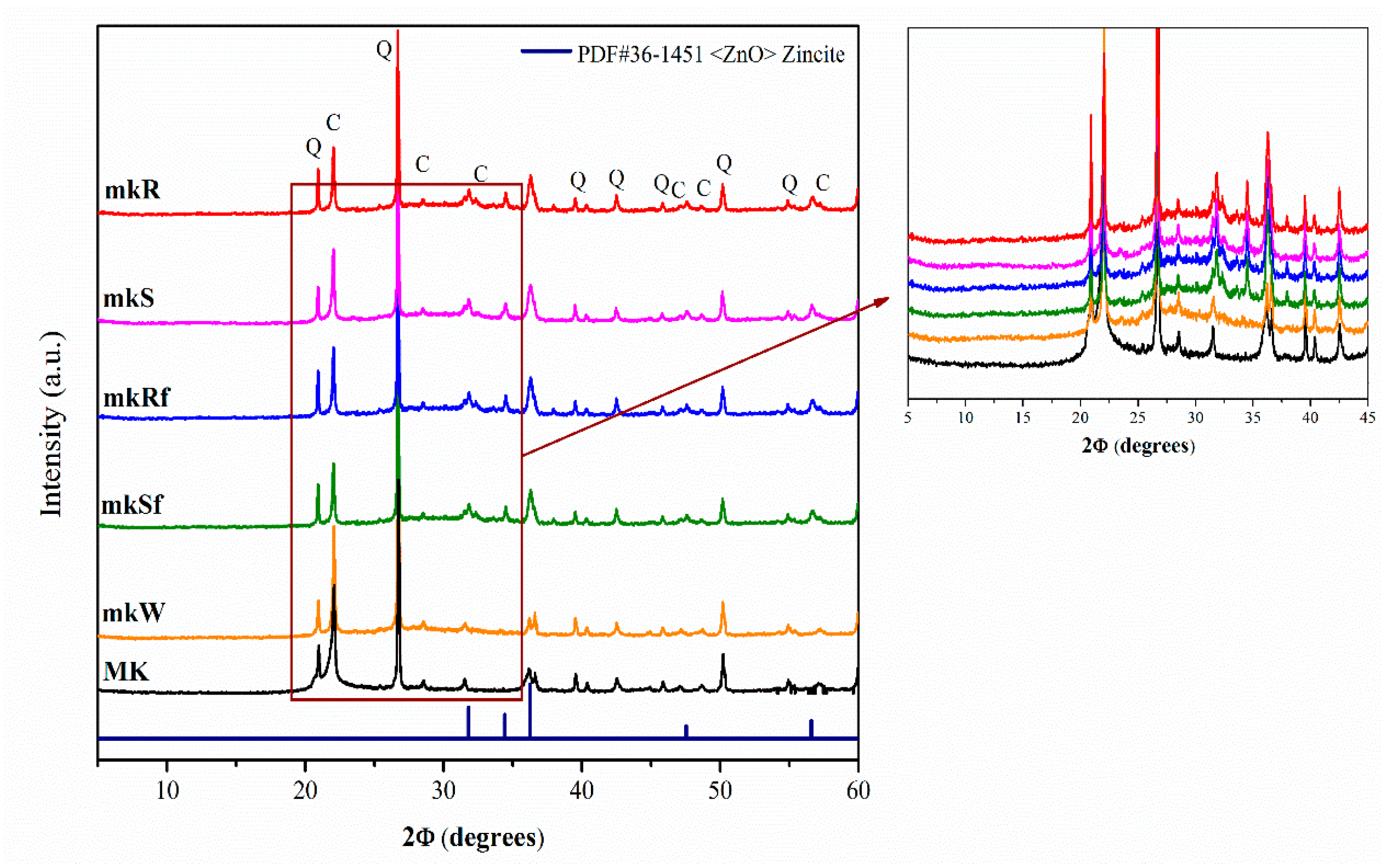
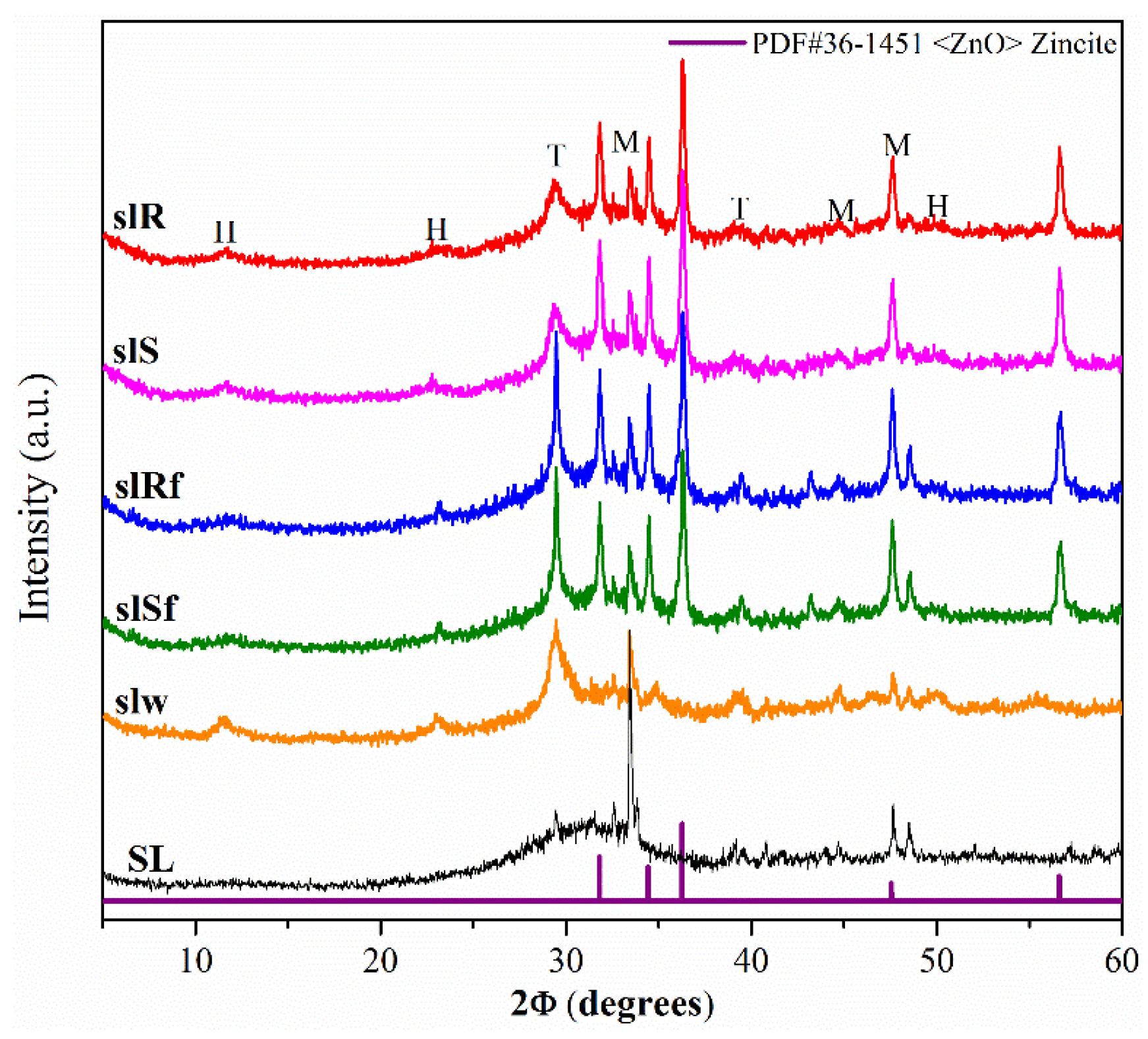
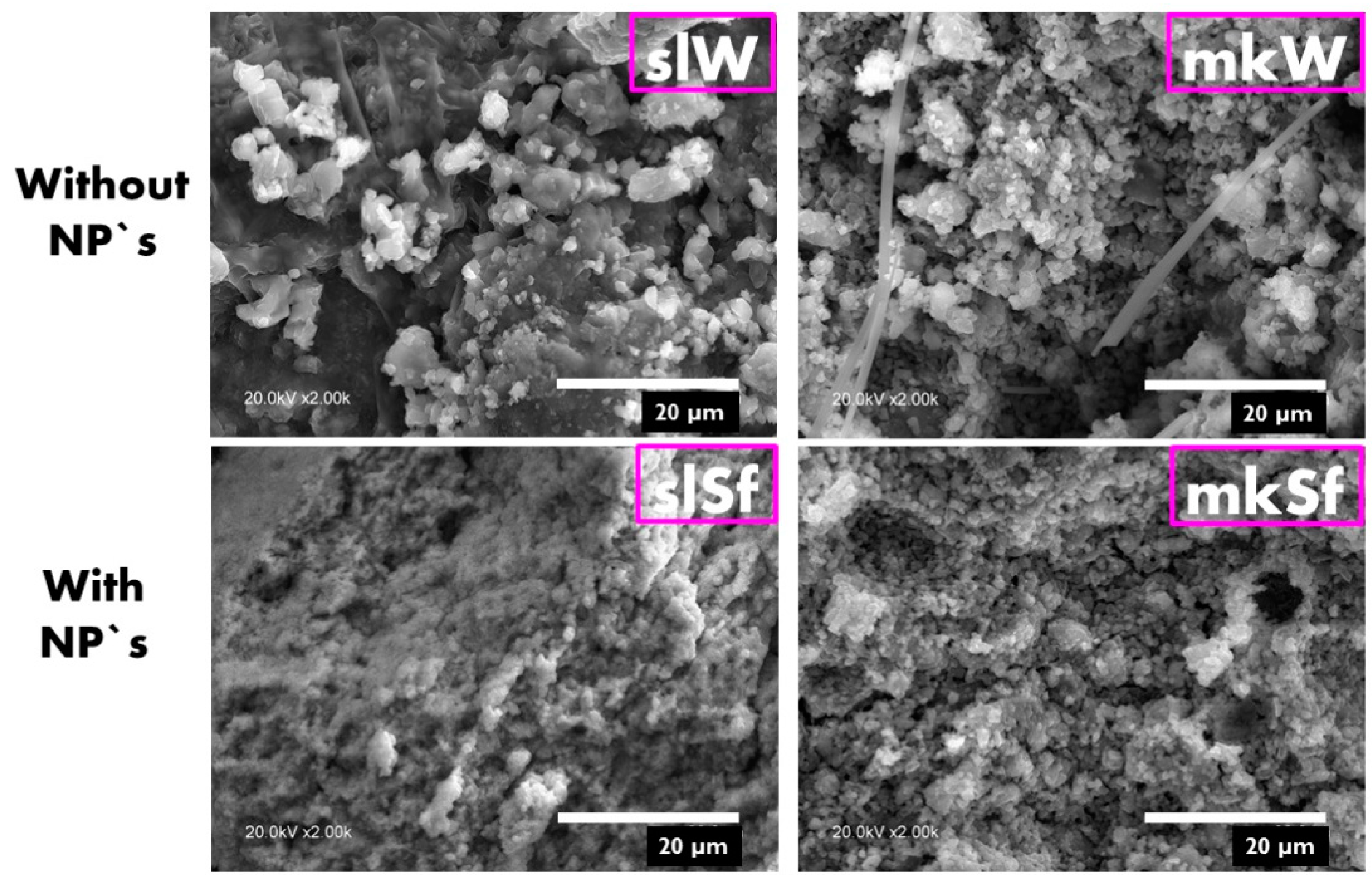
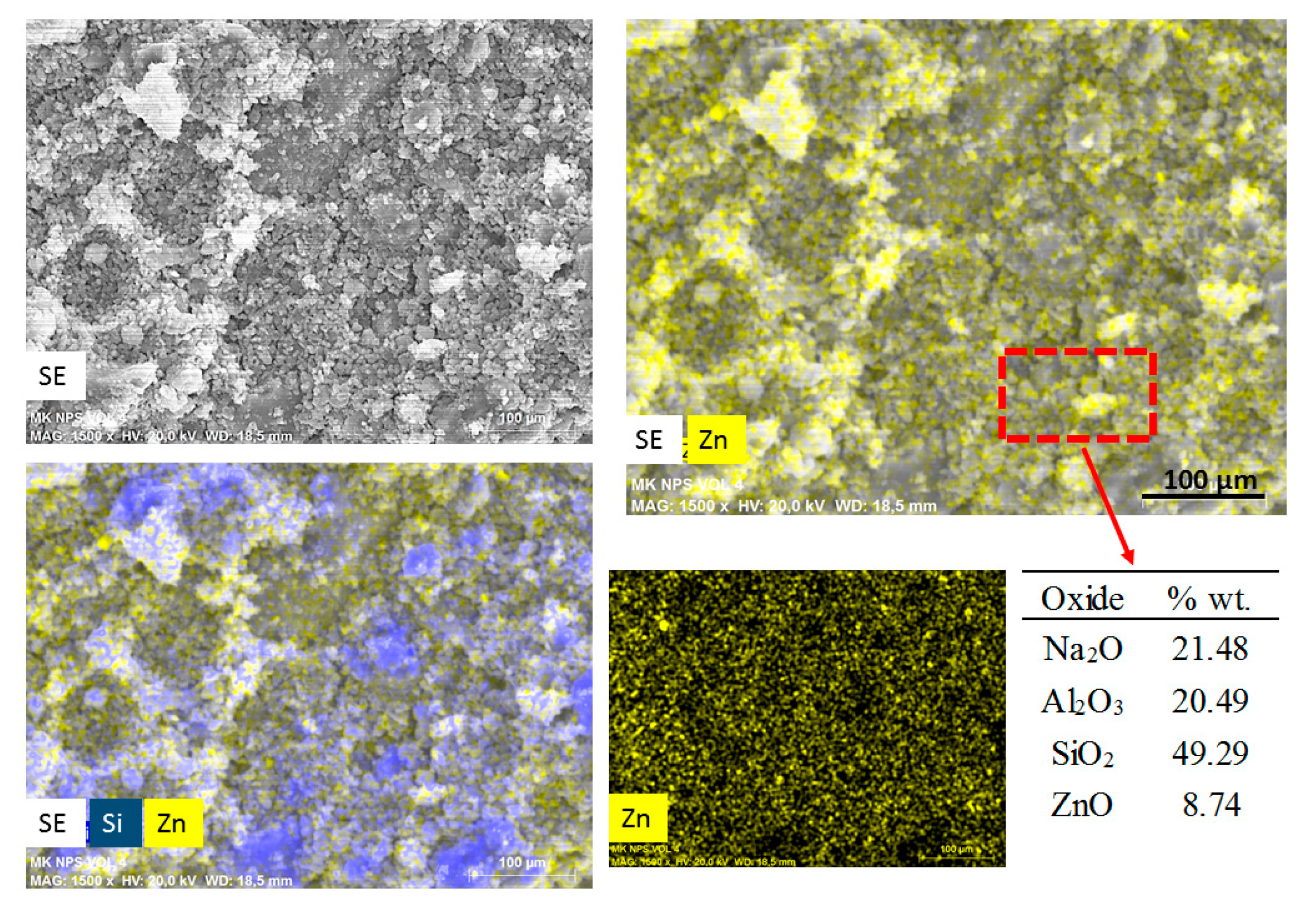
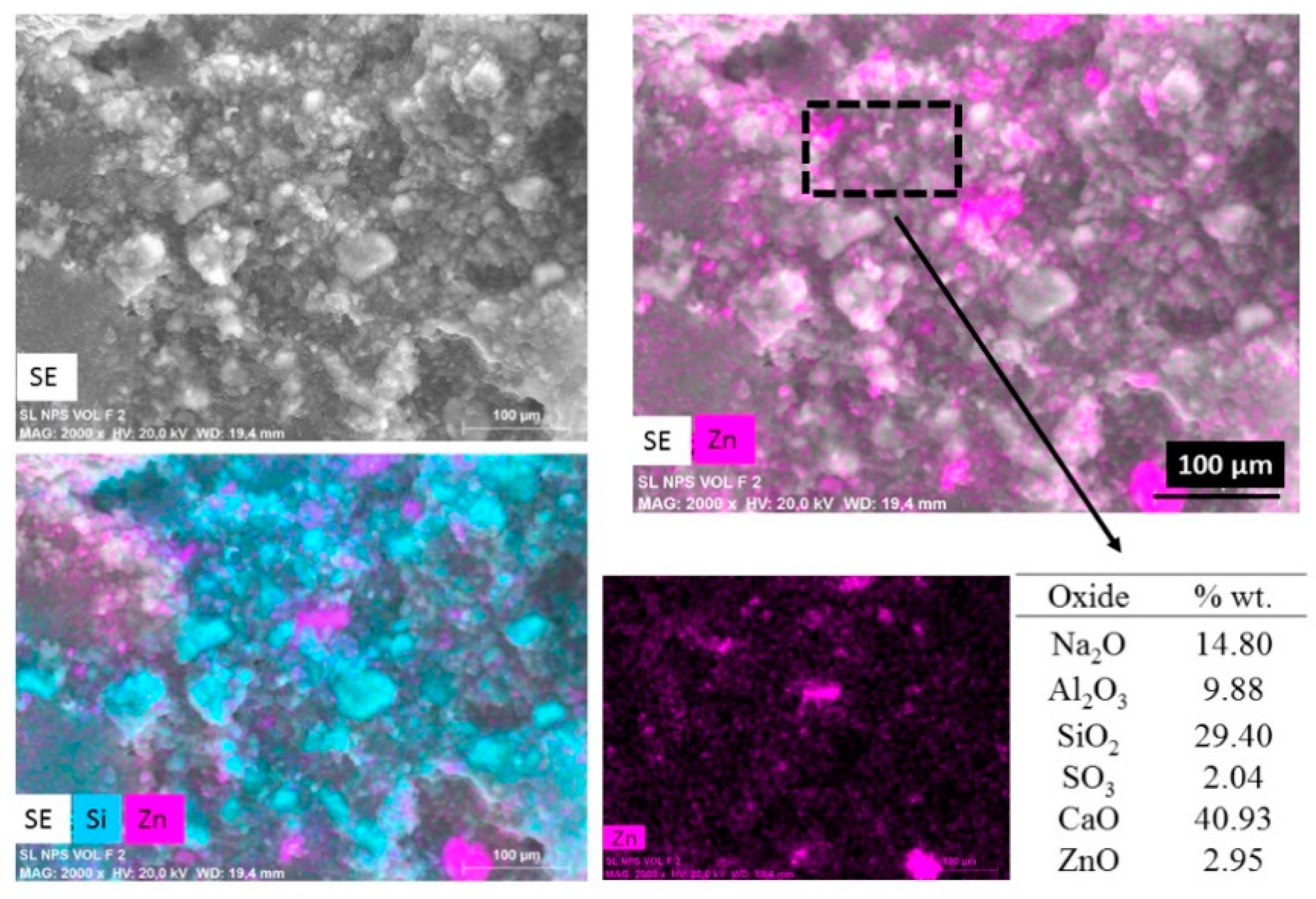
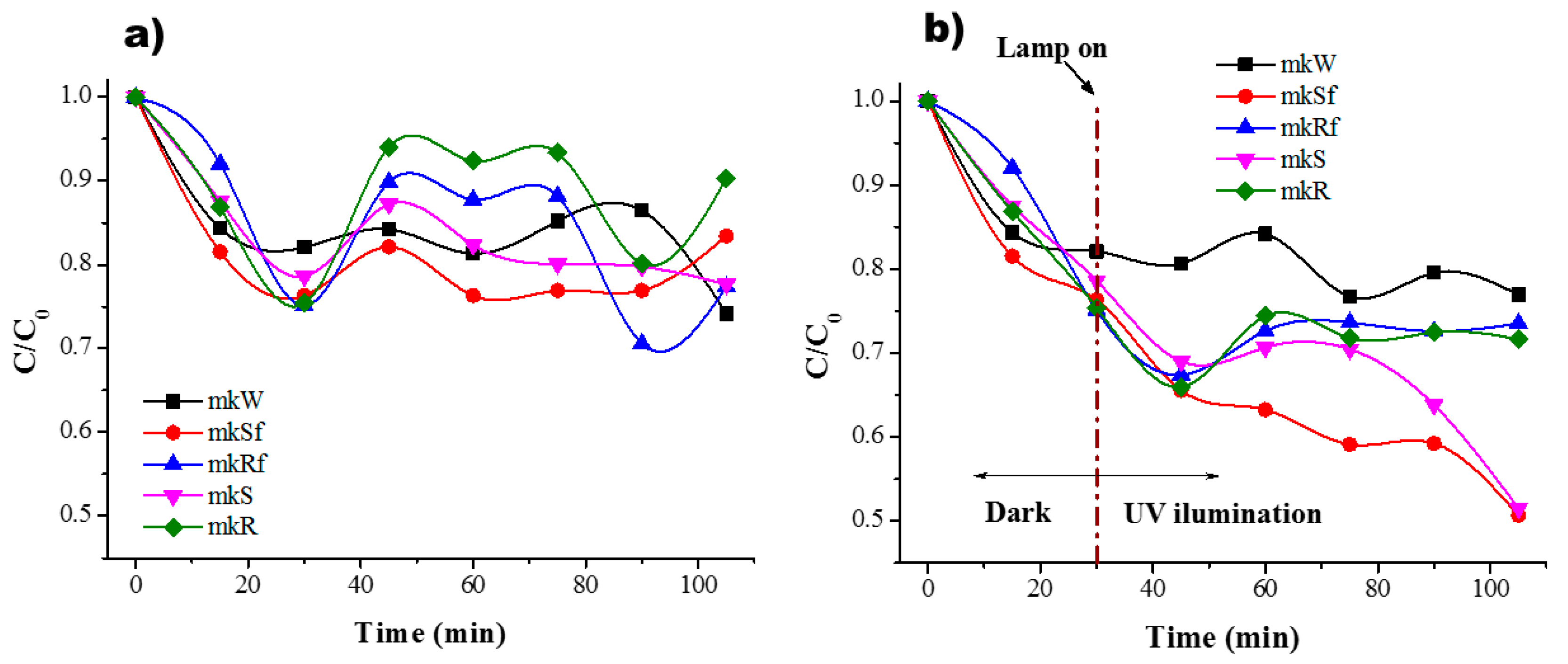

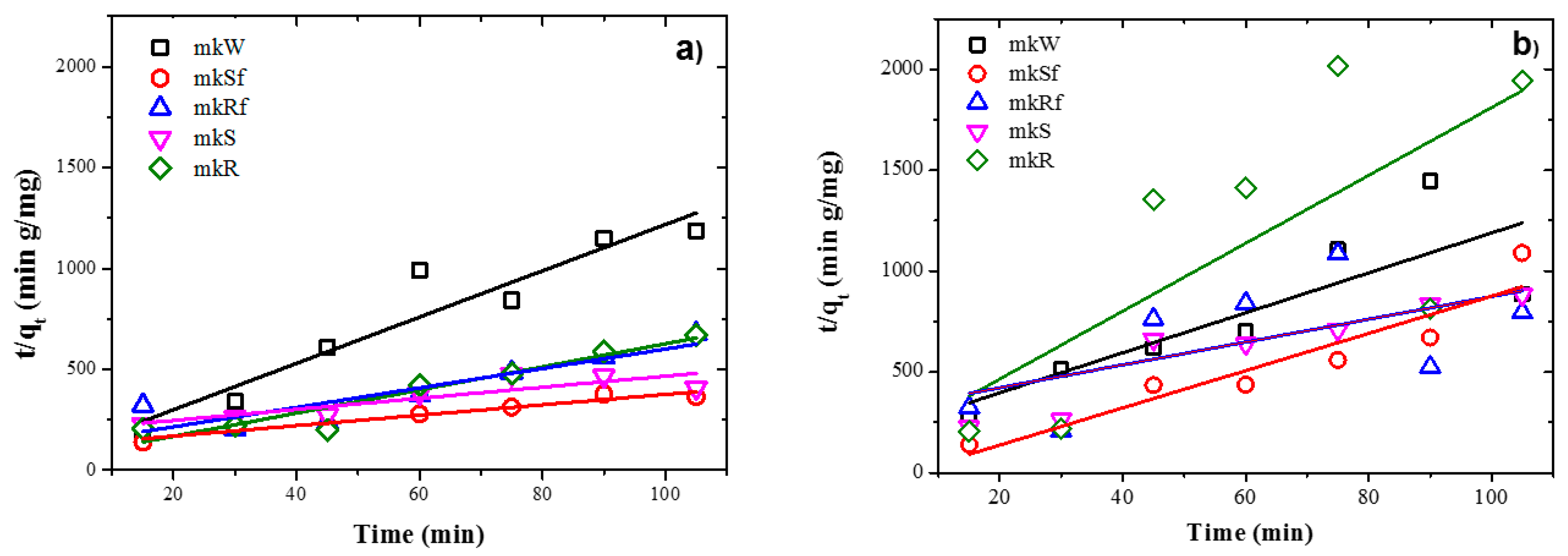

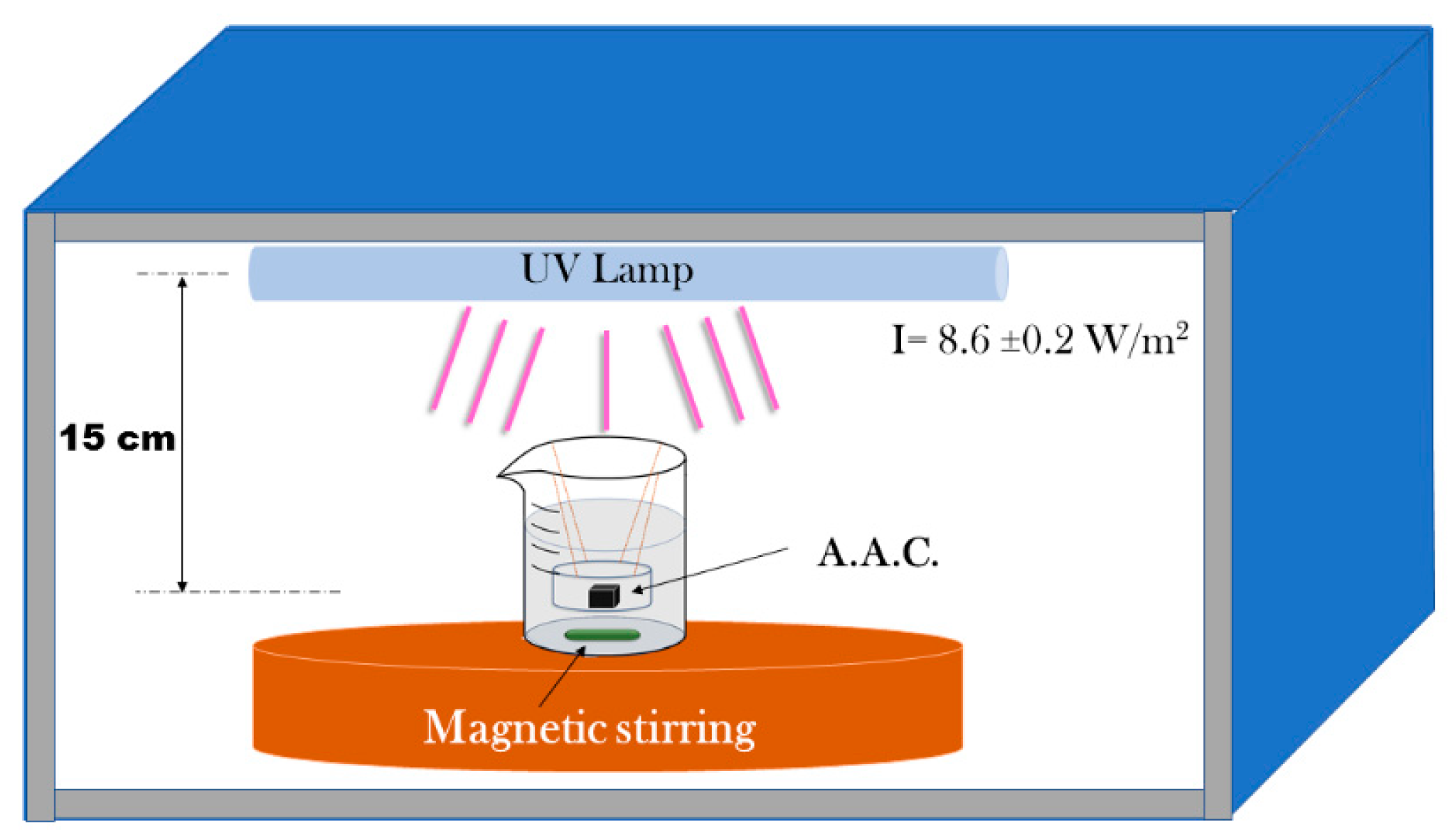
| Sample | Photolysis (%) | Adsorption (%) | Photodegradation (%) | Total Degradation (%) |
|---|---|---|---|---|
| Metakaolin | ||||
| mkW_Dark | 0.00 | 25.85 | 0.00 | 25.85 |
| mkW_UV | 5.03 | 18.06 | 0.00 | 23.09 |
| Nanospheres | ||||
| mkSf_Dark | 0.00 | 16.59 | 0.00 | 16.59 |
| mkSf_UV | 5.03 | 16.59 | 27.71 | 49.33 |
| mkS_Dark | 0.00 | 22.35 | 0.00 | 22.35 |
| mkS_UV | 5.03 | 22.35 | 21.10 | 48.48 |
| Nanorods | ||||
| mkRf_Dark | 0.00 | 22.66 | 0.00 | 22.66 |
| mkRf_UV | 5.03 | 18.06 | 3.38 | 26.47 |
| mkR_Dark | 0.00 | 9.70 | 0.00 | 9.70 |
| mkR_UV | 5.03 | 18.06 | 5.24 | 28.33 |
| Sample | Photolysis (%) | Adsorption (%) | Photodegradation (%) | Total Degradation (%) |
|---|---|---|---|---|
| Metallurgical slag | ||||
| slW_Dark | 0.00 | 30.22 | 0.00 | 30.22 |
| slW_UV | 5.34 | 30.22 | 0.00 | 35.56 |
| Nanospheres | ||||
| slSf_Dark | 0.00 | 11.42 | 0.00 | 6.14 |
| slSf_UV | 5.34 | 11.42 | 22.79 | 39.55 |
| slS_Dark | 0.00 | 17.14 | 0.00 | 17.14 |
| slS_UV | 5.34 | 17.14 | 13.33 | 35.81 |
| Nanorods | ||||
| slRf_Dark | 0.00 | 10.79 | 0.00 | 10.79 |
| slRf_UV | 5.34 | 10.79 | 12.39 | 28.52 |
| slR_Dark | 0.00 | 21.90 | 0.00 | 21.90 |
| slR_UV | 5.34 | 21.90 | 6.57 | 33.81 |
| Sample | Pseudo-First Order Parameter | Pseudo-Second Order Parameter | ||||
|---|---|---|---|---|---|---|
| k1 (min−1) | qe (mg/g) | R2 | k2 [g/(mg·min)] | qe (mg/g) | R2 | |
| Nanospheres | ||||||
| mkW_UV | 0.0003 | 723.000 | 0.0648 | 1.861 | 0.087 | 0.9126 |
| mkW_Dark | 0.0013 | 78.000 | 0.4709 | 0.495 | 0.101 | 0.6781 |
| mkSf_UV | 0.0049 | 30.592 | 0.9445 | 0.057 | 0.387 | 0.9485 |
| mkSf_Dark | 0.00004 | 5970.000 | 0.0013 | 1.791 | 0.108 | 0.8999 |
| mkS_UV | 0.0048 | 16.938 | 0.7584 | 0.039 | 0.364 | 0.8499 |
| mkS_Dark | 0.0010 | 14.180 | 0.4381 | 0.375 | 0.133 | 0.8801 |
| Nanorods | ||||||
| mkW_UV | 0.0003 | 723.000 | 0.0648 | 1.861 | 0.087 | 0.9126 |
| mkW_Dark | 0.0013 | 78.000 | 0.4709 | 0.495 | 0.101 | 0.6781 |
| mkRf_UV | 0.0016 | 122.313 | 0.2702 | 0.1956 | 0.208 | 0.8105 |
| mkRf_Dark | 0.0016 | 60.250 | 0.2441 | 0.1034 | 0.177 | 0.3480 |
| mkR_UV | 0.0011 | 231.364 | 0.0964 | 0.6143 | 0.174 | 0.9175 |
| mkR_Dark | 0.0050 | 34.040 | 0.0438 | 2.2081 | 0.059 | 0.5298 |
| Sample | Pseudo-First Order Parameter | Pseudo-Second Order Parameter | ||||
|---|---|---|---|---|---|---|
| k1 (min−1) | qe (mg/g) | R2 | k2 [g/(mg·min)] | qe (mg/g) | R2 | |
| Nanospheres | ||||||
| slW_UV | 0.0022 | 109.545 | 0.6033 | 0.345 | 0.190 | 0.9782 |
| slW_Dark | 0.0007 | 333.571 | 0.1325 | 1.279 | 0.114 | 0.8770 |
| slSf_UV | 0.0034 | 25.147 | 0.6954 | 0.080 | 0.214 | 0.7755 |
| slSf_Dark | 0.0004 | 361.500 | 0.0448 | 2.462 | 0.031 | 0.6952 |
| slS_UV | 0.0030 | 27.000 | 0.7913 | 0.082 | 0.202 | 0.7505 |
| slS_Dark | 0.0008 | 97.500 | 0.2642 | 0.170 | 0.095 | 0.2538 |
| Nanorods | ||||||
| slW_UV | 0.0022 | 109.545 | 0.6033 | 0.345 | 0.190 | 0.9782 |
| slW_Dark | 0.0007 | 333.571 | 0.1325 | 1.279 | 0.114 | 0.8770 |
| slRf_UV | 0.0033 | 26.485 | 0.2931 | 0.0032 | 0.664 | 0.5492 |
| slRf_Dark | 0.0006 | 146.333 | 0.1358 | 0.3698 | 0.081 | 0.5553 |
| slR_UV | 0.0032 | 51.7500 | 0.5695 | 0.1045 | 0.218 | 0.7664 |
| slR_Dark | 0.0005 | 320.800 | 0.0587 | 1.4725 | 0.081 | 0.7974 |
| Kaolin | SiO2 | Al2O3 | SO3 | K2O | P2O5 | TiO2 | CaO | Fe2O3 | ZnO | Others | LOI† |
| 66.79 | 19.26 | 1.93 | 0.62 | 0.40 | 0.23 | 0.11 | 0.10 | 0.001 | 0.119 | 10.43 | |
| Metallurgical Slag | CaO | SiO2 | MgO | Al2O3 | SO3 | TiO2 | Fe2O3 | Na2O | K2O | Others | |
| 44.76 | 30.52 | 10.20 | 9.59 | 2.51 | 0.74 | 0.61 | 0.38 | 0.35 | 0.35 |
Publisher’s Note: MDPI stays neutral with regard to jurisdictional claims in published maps and institutional affiliations. |
© 2020 by the authors. Licensee MDPI, Basel, Switzerland. This article is an open access article distributed under the terms and conditions of the Creative Commons Attribution (CC BY) license (http://creativecommons.org/licenses/by/4.0/).
Share and Cite
Guzmán-Carrillo, H.R.; Manzano-Ramírez, A.; Garcia Lodeiro, I.; Fernández-Jiménez, A. ZnO Nanoparticles for Photocatalytic Application in Alkali-Activated Materials. Molecules 2020, 25, 5519. https://doi.org/10.3390/molecules25235519
Guzmán-Carrillo HR, Manzano-Ramírez A, Garcia Lodeiro I, Fernández-Jiménez A. ZnO Nanoparticles for Photocatalytic Application in Alkali-Activated Materials. Molecules. 2020; 25(23):5519. https://doi.org/10.3390/molecules25235519
Chicago/Turabian StyleGuzmán-Carrillo, Hector R., Alejandro Manzano-Ramírez, Ines Garcia Lodeiro, and Ana Fernández-Jiménez. 2020. "ZnO Nanoparticles for Photocatalytic Application in Alkali-Activated Materials" Molecules 25, no. 23: 5519. https://doi.org/10.3390/molecules25235519
APA StyleGuzmán-Carrillo, H. R., Manzano-Ramírez, A., Garcia Lodeiro, I., & Fernández-Jiménez, A. (2020). ZnO Nanoparticles for Photocatalytic Application in Alkali-Activated Materials. Molecules, 25(23), 5519. https://doi.org/10.3390/molecules25235519







